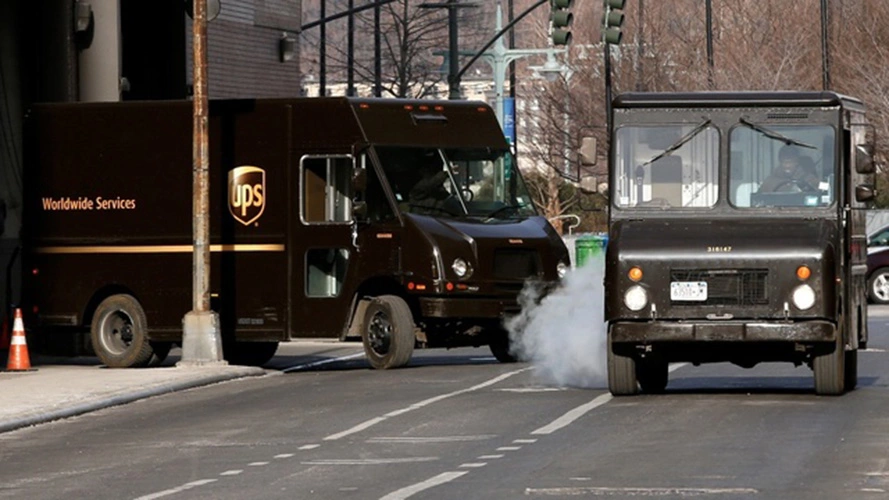UPS Ship Food: Can You Ship Frozen Food With Ups?
UPS ship food is crucial to know because shipping food has become increasingly popular in recent years, as people seek convenient ways to send gifts, access specialty items, and explore culinary delights from around the world. As you read through, we will show you why you need to ship food using UPS.

Ups Ship Food
The concept of shipping food opens up a world of possibilities, allowing individuals to send care packages, share unique local flavors, or indulge in gourmet treats that may not be available in their area.
With UPS’s extensive network, reliable service, and commitment to food safety, it has become a trusted choice for many when it comes to shipping perishable and non-perishable food items.
If you’re curious about how to send delicious surprises to your loved ones, source unique ingredients, or embark on a culinary adventure from the comfort of your home, read on to discover the world of UPS food shipping.
READ ALSO!!!
- UPS Shipping Calculator | UPS Rates and Cost Estimates 2023
- UPS Shipping API | Benefits and Utilizations
- What is UPS Ground? An Introduction to UPS Ground Services
- UPS Shipping Restrictions and Prohibited Items
Why Ship Food?
Shipping food has become a preferred choice for many individuals and businesses for several compelling reasons. Let’s explore the key motivations behind the growing trend of shipping food:
1. Convenience
Shipping food offers unparalleled convenience, especially when sending gifts or care packages to friends, family, or business associates.
It eliminates the need to physically shop for and transport items, saving time and effort.
2. Access to Specialty and Gourmet Foods
Shipping food allows individuals to access a wide range of specialty or gourmet items that may not be readily available in their local area.
Whether it’s a unique cheese from a small artisan producer, exotic spices, or rare delicacies, shipping opens up a world of culinary possibilities.
3. Perishable Item Delivery
One of the significant advantages of shipping food is the ability to send perishable items over long distances.
Whether it’s fresh seafood, farm-fresh produce, or bakery goods, advanced packaging, and shipping methods ensure that these delicate items reach their destination in optimal condition.
4. Exploring International Cuisine
Shipping food also provides an exciting opportunity to explore international cuisine without leaving home.
By ordering authentic ingredients or pre-prepared meals from different parts of the world, individuals can indulge in diverse flavors and expand their culinary horizons.
5. Supporting Small Businesses
Shipping food can be a way to support local or small-scale food producers.
By purchasing their products and shipping them to a wider audience, individuals can help these businesses thrive and promote unique, high-quality food products.
6. Dietary Restrictions and Preferences
For individuals with specific dietary restrictions or preferences, shipping food ensures access to suitable options.
Whether it’s vegan, gluten-free, or allergen-free products, shipping allows individuals to source specialized food items that align with their needs.
7. Convenience for Travelers
Travelers often face challenges in finding familiar or preferred foods while away from home.
Shipping food provides a solution by allowing them to send their preferred snacks or meals to their destination, ensuring comfort and familiarity during their travels.
The UPS Advantage

When it comes to shipping food, UPS offers several advantages that make it a reliable and trusted choice. Let’s explore the UPS advantage in shipping food:
1. Expertise in Handling Perishable and Fragile Items
UPS has extensive experience in handling perishable and fragile items, making it well-equipped to ship food safely.
With specialized packaging, temperature-controlled options, and handling protocols, UPS ensures that perishable items maintain their freshness and integrity throughout the shipping process.
2. Extensive Network and Coverage
UPS has an extensive network and global coverage, enabling food shipments to reach various destinations reliably.
Whether it’s within a local area, across the country, or internationally, UPS’s robust logistics infrastructure ensures timely and efficient delivery.
3. Commitment to Food Safety and Proper Handling
UPS prioritizes food safety and proper handling throughout the shipping journey.
The company adheres to strict guidelines and best practices for packaging, labeling, and temperature control to maintain the quality and safety of food items during transit.
4. Tracking and Visibility
UPS provides advanced tracking and visibility tools that allow both senders and recipients to monitor the progress of their food shipments.
This feature provides peace of mind and ensures transparency throughout the delivery process.
5. Additional Services
UPS offers a range of additional services that enhance the food shipping experience.
These include insurance options to protect against loss or damage, customs clearance services for international shipments, and flexible delivery options that cater to the recipient’s schedule or preferences.
6. Sustainability Initiatives
UPS is committed to sustainability and has implemented various eco-friendly practices.
These include optimizing routes for fuel efficiency, using alternative fuel vehicles, and implementing recycling and waste reduction programs.
By choosing UPS for food shipping, individuals can align their shipping needs with environmentally responsible practices.
With its expertise in handling perishable items, extensive network coverage, commitment to food safety, advanced tracking tools, additional services, and sustainability initiatives,
UPS offers a distinct advantage when it comes to shipping food. Individuals can trust UPS to ensure the timely, safe, and reliable delivery of their food shipments, making it an excellent choice for both personal and business needs.
The Importance of Packaging and Preparation
Proper packaging and preparation are crucial when shipping food to ensure its freshness, safety, and overall quality.
Consider the following guidelines to effectively package and prepare your food shipments:
1. Choose Suitable Packaging Materials
Select packaging materials that are appropriate for the type of food being shipped.
Use sturdy and insulated containers for perishable items, such as coolers or foam containers, to maintain proper temperature control.
For non-perishable items, such as dry goods or canned goods, use durable boxes or packaging materials that provide adequate protection.
2. Use Inner Packaging
Within the main container, use additional inner packaging to secure the food items and prevent movement during transit.
Bubble wrap, packing peanuts, or crumpled paper can be used as fillers to create a cushioning effect and reduce the risk of breakage or damage.
3. Consider Temperature Control
For perishable items that require temperature control, such as fresh produce, dairy products, or frozen foods, use appropriate cooling or heating elements.
Gel packs, dry ice, or thermal insulation can help maintain the desired temperature during transit. Ensure that the packaging is leak-proof to avoid any moisture-related issues.
4. Preserve Freshness
To preserve the freshness of food items, consider vacuum-sealing or using airtight containers.
This method can help extend the shelf life and prevent exposure to air, moisture, or odors that could affect the quality of the food during shipping.
5. Label Clearly
Clearly label the packages with the necessary information, including the sender’s and recipient’s addresses, contact numbers, and any special handling instructions.
Indicate if the package contains perishable items to ensure proper handling by UPS and any necessary precautions.
6. Timing and Scheduling
Plan the shipping date carefully to minimize the transit time and ensure that the food items arrive at their destination as fresh as possible.
Coordinate with UPS to schedule the pickup or drop-off at the most suitable time to avoid unnecessary delays or prolonged storage.
7. Consider Customs Regulations
If shipping food internationally, research and comply with the customs regulations of the destination country.
Some countries have restrictions or specific requirements for importing food items, such as labeling, documentation, or permits.
Ensure that all necessary customs forms and declarations are accurately completed.
8. Follow Food Safety Guidelines
Adhere to basic food safety guidelines to ensure the quality and safety of the shipped food. This includes proper handling, storage temperatures, and avoiding cross-contamination during the packaging and preparation process.
Shipping Options and Services

UPS offers a variety of shipping options and services to cater to different needs when it comes to shipping food.
Consider the following options to determine the most suitable choice for your specific requirements:
1. Ground Shipping
Ground shipping is a cost-effective option for non-perishable or shelf-stable food items.
It is ideal for sending dry goods, canned goods, snacks, or non-perishable ingredients.
Ground shipping is suitable for domestic shipments within the same country or region.
2. Air Shipping
Air shipping is recommended for time-sensitive or perishable food items that require expedited delivery.
It ensures faster transit times, reducing the risk of spoilage or deterioration of perishable goods.
Air shipping is also suitable for sending food items across longer distances, including international shipments.
3. International Shipping
UPS provides international shipping services, allowing you to send food items to various countries worldwide.
International shipping opens up opportunities to explore global cuisines, send unique local delicacies, or share cultural food experiences.
When shipping food internationally, be aware of customs regulations, restrictions, and any required documentation for importing food items into the destination country.
4. Tracking and Insurance
UPS offers advanced tracking capabilities, allowing you to monitor the progress of your food shipments in real time.
Take advantage of the tracking feature to stay informed about the estimated delivery time and ensure the recipient’s availability.
Additionally, consider opting for insurance coverage to protect your food shipments against loss, damage, or theft during transit.
5. Customs Clearance
If you are shipping food internationally, UPS provides customs clearance services to facilitate the smooth movement of your packages through customs.
UPS can assist with completing necessary customs forms, handling import duties or taxes, and ensuring compliance with customs regulations.
6. Flexible Delivery Options
UPS offers flexible delivery options to accommodate the recipient’s schedule and preferences.
Services like UPS My Choice allow recipients to customize their delivery preferences, such as rescheduling delivery, redirecting packages to a different address, or authorizing package release without requiring a signature.
When shipping food, consider the nature of your items, the desired delivery speed, and any special requirements (such as temperature control) to determine the most appropriate shipping option.
Additionally, take advantage of UPS’s tracking, insurance, customs clearance, and flexible delivery services to enhance your shipping experience and ensure the successful arrival of your food shipments.
Tips for Successful Food Shipping
Shipping food requires careful consideration to ensure that the items arrive fresh, safe, and in optimal condition. Follow these tips to increase the chances of a successful food shipping experience:
1. Select Suitable Foods
Choose food items that are suitable for shipping. Opt for items that have a longer shelf life, are less prone to damage or spoilage, and can withstand the shipping process without compromising quality.
2. Package with Care
Proper packaging is essential for preserving the freshness and integrity of the food during transit.
Use sturdy and insulated containers, and inner packaging materials to prevent movement, and consider temperature control elements like gel packs or dry ice when necessary.
3. Consider Temperature Control
For perishable items, maintain proper temperature control throughout the shipping process.
Use appropriate cooling or heating elements to ensure that the food remains within the safe temperature range. Label packages with instructions for temperature-sensitive items.
4. Timing is Crucial
Plan the shipping timing carefully to minimize the transit time. Consider the estimated delivery date, especially for perishable items, to ensure that they arrive at their destination in the best possible condition.
Avoid shipping food during extreme weather conditions that could affect its quality.
5. Label Clearly and Accurately
Ensure that all packages are clearly labeled with the sender’s and recipient’s addresses, contact information, and any special handling instructions.
Indicate if the package contains perishable items to alert UPS and ensure proper handling.
6. Consider Fragile Items
If shipping delicate or fragile food items, take extra precautions to protect them. Wrap fragile items individually, use appropriate cushioning materials, and mark the packages as fragile to alert handlers.
7. Research Customs Regulations
If shipping food internationally, research and comply with the customs regulations of the destination country.
Understand any restrictions or specific requirements for importing food items, such as labeling, documentation, or permits.
8. Communicate with Recipients
Inform the recipients about the expected delivery date and any specific instructions for receiving the food packages.
Coordinate with them to ensure that someone will be available to receive the shipment and promptly store perishable items.
9. Consider Shipping Insurance
Consider opting for shipping insurance to protect your food shipments against loss, damage, or theft during transit. UPS offers insurance options that can provide peace of mind and financial protection.
10. Test Packaging and Shipping Methods
Before sending valuable or delicate food items in bulk, consider conducting a test shipment to evaluate the packaging and shipping methods.
This allows you to identify any potential issues or make necessary adjustments to ensure successful future shipments.
READ ALSO!!!
- How to Easily Request a UPS Change of Address
- How to Request a UPS Refund and Reclaim Your Shipping Costs
- Can I Ship Plants with UPS Express?
- How Do I Calculate the Shipping Time for UPS Express?
Customer Experiences and Success Stories
Real-life customer experiences and success stories can provide valuable insights into the effectiveness and benefits of shipping food through UPS. Here are a few examples:
1. Jane’s Gourmet Treats
Jane, a small-scale gourmet baker, successfully ships her homemade cookies and pastries using UPS.
Her customers rave about the freshness and quality of the treats upon arrival. UPS’s reliable delivery ensures that Jane’s baked goods reach customers across the country in perfect condition, allowing her to expand her business beyond local boundaries.
2. Global Taste Explorations
Mark, an avid food enthusiast, loves exploring international flavors. He orders specialty ingredients, sauces, and spices from different parts of the world and ships them through UPS.
Mark appreciates UPS’s global shipping services, which enable him to experiment with diverse cuisines and enjoy authentic flavors from the comfort of his kitchen.
3. Care Packages for Loved Ones
Sarah frequently ships care packages filled with her family’s favorite homemade preserves, sauces, and snacks to her loved ones across the country.
With UPS, she can send thoughtful and personalized gifts to her family members, ensuring that the items arrive in excellent condition and bring joy to their doorstep.
4. Farm-to-Table Delivery
James, a farmer with a thriving organic produce business, relies on UPS to deliver his farm-fresh fruits and vegetables to customers in distant cities.
The prompt and reliable service of UPS allows James to maintain the quality and freshness of his produce, building a loyal customer base that values his commitment to sustainable and local food sources.
Food Shipping Regulations and Legal Considerations
When shipping food, it is important to be aware of and comply with relevant regulations and legal considerations to ensure food safety, maintain quality, and prevent any legal issues. Here are some key points to consider:
1. Research Local and International Regulations
Familiarize yourself with the local, national, and international regulations regarding shipping food.
Different regions and countries may have specific rules and requirements for importing or shipping food items, including labeling, documentation, packaging, and handling procedures.
2. Perishable Food Restrictions
Some countries may have restrictions on the importation of certain perishable food items. Research whether the food you intend to ship falls under any prohibited or restricted categories.
This could include fresh produce, meat, dairy products, or certain types of seafood. Be aware of any permits, certifications, or inspections required for specific types of food.
3. Labeling and Packaging Requirements
Ensure that your food shipments comply with labeling and packaging requirements.
Some regulations may specify the need for clear and accurate labeling, including ingredient lists, nutritional information, allergen warnings, and country of origin.
Packaging materials may need to meet specific safety and hygiene standards, such as being tamper-evident or leak-proof.
4. Food Safety Compliance
Prioritize food safety throughout the shipping process. Follow proper food handling, storage, and temperature control practices to maintain the quality and safety of the food during transit.
Be aware of any regulations governing food safety practices, such as the Hazard Analysis and Critical Control Points (HACCP) system, and implement them accordingly.
5. Customs Documentation
When shipping food internationally, customs documentation plays a crucial role. Complete all necessary customs forms accurately and provide any required information related to the nature, quantity, and value of the food items being shipped.
Be aware of any restrictions or specific requirements for importing food items into the destination country, including permits, licenses, or health certificates.
6. Consult Experts and Authorities
If you have specific concerns or questions regarding the regulations and legal considerations for shipping food, consult relevant authorities or seek advice from legal and regulatory experts.
They can provide guidance based on your specific circumstances and help ensure compliance with applicable rules.
7. Liability and Insurance
Understand the liabilities associated with shipping food. Consider obtaining shipping insurance to protect your food shipments against loss, damage, or spoilage during transit.
Review UPS’s insurance options or consult with your insurance provider to determine the most suitable coverage for your needs.
By understanding and adhering to food shipping regulations and legal considerations, you can ensure compliance, maintain food safety standards, and prevent any potential issues during the shipping process.
Researching and staying informed about the regulations specific to your destination will help facilitate smooth and successful food shipments.
Conclusion
Shipping food through UPS offers a convenient and reliable solution for sending gifts, accessing specialty items, and exploring culinary delights from around the world.
By following proper packaging and preparation guidelines, utilizing UPS’s expertise and services, and being aware of food shipping regulations and legal considerations, you can ensure successful food shipments.
So, whether you’re sending homemade treats, supporting small food businesses, or embarking on a culinary adventure, UPS provides the tools and expertise to make your food shipping experience a success.
Explore the possibilities and savor the satisfaction of sharing delicious surprises with others through UPS food shipping services.
